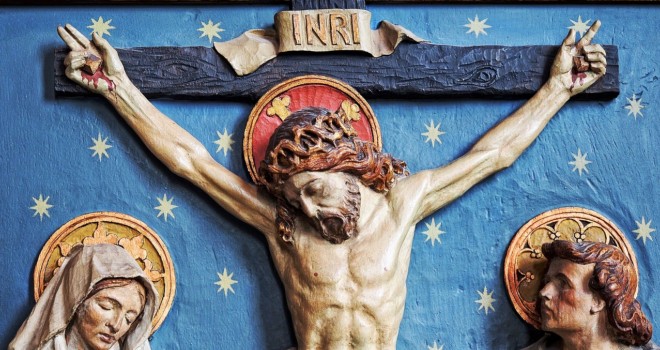In 1951, the great Spanish artist Salvador Dali set out to depict the crucifixion of Christ in a way no other person had.
In the image, Christ is affixed to the cross, yet there are no nails. His body is twisted and head is bowed, yet the scene is utterly tranquil. The cross is aloft and cross looks down on a compressed panorama of clouds, mountains, and a sea. High above the earth, it is almost as if Christ is encompassing the world in the embrace of his arms, stretched out like the wings of a magnificent eagle.
Dali’s painting may depart from the literal, historical accounts of the crucifixion, but it testifies to a great spiritual truth. One Catholic writer explains it this way:
Dali has removed the nails from Christ’s hands and feet—and by sheer use of colour gives the impression that the limbs of the cross are reaching out across all time and space—across the face of the earth. It is as if the painting is teaching us that there is no limit to the span of Christ’s love, neither in the breadth or in depth of how God loves.
Scripture teaches that all things were created through Christ. Moreover, Christ not only fashioned all things, He also continues to sustain and enable all of creation. While not being identical with creation, in a very real sense, Christ contains all things within Himself. Colossians 1:16 declares that ‘in Him were created all things in heaven and on earth.’ In Acts 17:28, St. Peter preaches that ‘in Him we live and move and have our being.’ Likewise, in Ephesians 1:10, St. Paul says that all things are ‘summed up’ in Christ.
Throughout His ministry, Christ expressed His love for men in imagery that reflects this reality:
Jerusalem, Jerusalem, you who kill the prophets and stone those sent to you, how many times I yearned to gather your children together, as a hen gathers her young under her wings, but you were unwilling! (Matthew 23:37).
Then there is the parable of how the Father embraced the Prodigal Son:
So he got up and went back to his father. While he was still a long way off, his father caught sight of him, and was filled with compassion. He ran to his son, embraced him and kissed him (Luke 15:20).
The cross is Christ’s definitive all-encompassing embrace of all of humanity. Christ’s literal stretching signifies the limitless expansion of his love—out in all four directions. As Paul writes in Ephesians 3:18-19, the extent of God’s love is so incredible that we need ‘strength’ in order to ‘comprehend the breadth and length and height and depth’ of it.
We can discern two dimensions to this love. The first is represented in the outstretched arms—spanning the whole of humanity. In the Summa Theologia, St. Thomas Aquinas teaches that Christ experienced the greatest possible suffering in the crucifixion. In other words, He bore the suffering of all mankind. This means there is no suffering, no tragedy, and no yearning or emptiness that is not touched by Christ on the cross.
The second dimension of Christ’s stretching is the vertical axis of the cross, connecting heaven and earth. In Christ, the love of heaven descends to us. And, in Christ, we are lovingly drawn up with Him to heaven. As Christ Himself says in John 12:32, ‘When I am lifted up from the earth, I will draw everyone to myself.’
Christ’s stretching of self on the cross is both a consolation and a calling to us. He beckons us closer to Him not only so that we might enter into His love but also that we might imitate it. Just as Christ was stretched outwards to all men and upwards to heaven, so also must we stretch our souls. We must reach out to the periphery and fringes, making even the stranger and the enemy our neighbor that we love.
St. John Chrysostom, whose feast day was yesterday, explains it this way:
When our emotions are deep toward a person or event, it means that we cannot ignore that person or event, but must remain closely involved. When our emotions are wide and open, it means that we can respond to many people and events, not just a few. Jesus had deep emotions of love toward people, and he prayed deeply about every event in their lives; and he also had wide emotions, loving everyone he encountered with equal depth. This is how we must aspire to become. Shallow emotions lead to apathy and complaining; so they make is indifferent toward other people and toward the events which shape their lives. And narrow emotions enable us to ignore the cries of pain and suffering that we hear all around us. To be a Christian means to extend one’s heart both downward and outward” (cited here).
Just as we follow the example of Christ in stretching ourselves out to our fellow man, so also must we emulate him in reaching for heaven. This, paradoxically, requires not a movement upwards but downwards. It leads us to radical humility and submission of the will. Christ showed the way forward not only through the cross but in his subsequent descent to the dead—to the domain of hell.
Paul says that through we relive this in our own lives. In fact, the apostle is more literal than this. He says that in Christ we actually participate, in some mystical way, in this journey of descent and ascent. “We were indeed buried with him through baptism into death, so that, just as Christ was raised from the dead by the glory of the Father, we too might live in newness of life,” (Romans 6:4).
In a sense, we all must ‘die to ourselves’ to experience this heavenly ascent. “I have been crucified with Christ; yet I live, no longer I, but Christ lives in me,” (Galatians 2:20).
Christ’s all-encompassing love is well illustrated for us in traditional images of the Sacred Heart. In the historical crucifixion, of course, Christ was on the cross and His heart was pierced on His side. But, in the image of the Sacred Heart, this is reversed: Christ’s heart has been enlarged, engulfing the cross, which is now planted in it.
We too must enlarge our hearts. For St. Philip Neri, this became a literal reality. The traditional story says that during vespers for Pentecost in 1544 Philip saw a fiery orb enter his mouth and descend to his chest, leaving it swollen for the rest of his life. Upon his death, it was discovered that he had had two ribs broken and bent outwards to accommodate his enlarged heart (I am summarizing this source here).
In the moment, Philip suffered great pain. But that pain was later transformed into lasting joy. Needless to say, the stretching of our hearts is likely to be painful—if not physically, then emotionally and spiritually. But imagine what kind of a joy is possible in a Christ-like heart whose love stretches to the ends of the earth and all the way up to heaven.
✠












